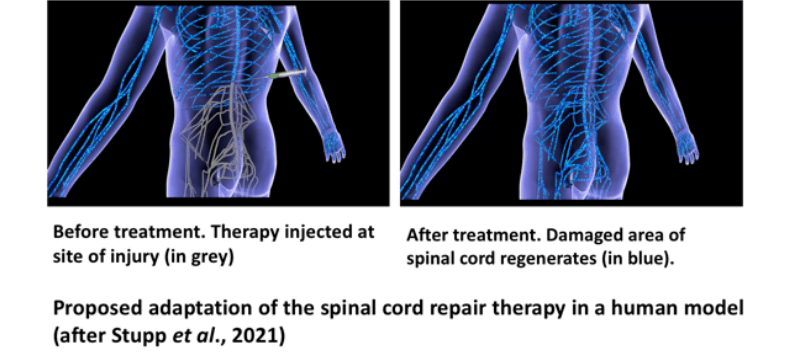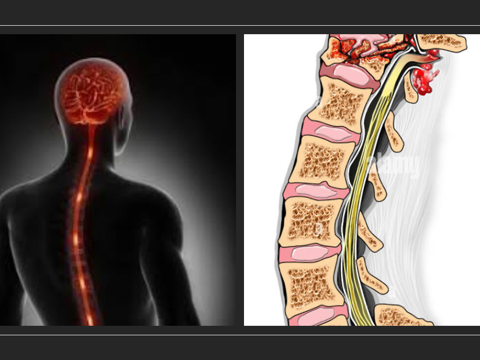There is now hope of survival for victims of spinal cord injury as a new study published on Friday has found that it is possible to repair and regenerate damaged spinal cord through a benign and unobtrusive biomedical treatment process.
A paper published in the Journal of Science revealed that some researchers, Prof Samuel Stupp, Zaida Alvarez, Kolberg-Edelbrock, Ivan Sasselli, Juan Ortega, Zois Syrgiannis, Peter Mirau, Feng Chen, Stacey Chin, Steven Weigand, and Evangelos Kiskinis, at Northwestern University have developed a new injectable therapy that optimises what they called “dancing molecules” to repair tissues after severe spinal cord injuries.
Join our WhatsApp Channel
Spinal cord injury is a damage of the spinal cord caused by either trauma (e.g. vehicle accident, a fall from a height) or degenerative diseases leading to neurological disorder such as loss of sensation or inability to feel or move parts of the body controlled by nerves affected, leading to complete or partial paralysis depending on severity of the damage or injury.
According to the World Health Organisation (WHO), between 250,000 and 500,000 persons suffer spinal cord injury every year around the world.
In the study, Stupp and his co-researchers used mice suffering paralysis as a result of damaged spinal cord for experiment to see how the therapy works.
READ ALSO: Spinal Cord Repair Therapy: Paralysed Mice Walk Again
The researchers manipulated tissue cells surrounding spinal cord of the paralyzed mice by injecting bioactive molecules, monitoring them, and after four weeks, the animals were able to walk again.
The molecules are said to trigger bioactive signals which causes cells repair and regeneration, thereby improving severely injured spinal cord.
The researchers’ breakthrough worked by manipulating the motion of molecules to constantly engage moving cellular receptors, such that when the liquid therapy is injected, it gels into a network of nanofibres which mimics extracellular matrix of the spinal cord.
“By matching the matrix’s structure, mimicking the motion of biological molecules and incorporating signals for receptors, the synthetic materials are able to communicate with cells,” said Stupp.
“Receptors in neurons and other cells constantly move around.
“The key innovation in our research, which has never been done before, is to control the collective motion of more than 100,000 molecules within our nanofibers. By making the molecules move, ‘dance’ or even leap temporarily out of these structures, known as supramolecular polymers, they are able to connect more effectively with receptors,” Stupp further stated.
They found that optimising the motion of molecules within the nanofibre network, made them more agile, resulting in high efficacy of the therapy on the paralyzed mice.
READ ALSO: COP26: China, India In Last-minute Pushback On Fossil Fuels, Coal
The therapy is said to work in five dramatic ways to improve injured spinal cord:
(1) The severed extensions of neurons, called axons, regenerated; (2) scar tissues, which are said to create physical barriers for tissue regeneration and repair, significantly depleted; (3) myelin, which is an insulating layer of axons that is important in transmitting electrical signals efficiently, reformed around cells; (4) functional blood vessels formed to deliver nutrients to cells at the injury site; and (5) more motor neurons survived.
Habits Dangerous To Your Brain
According to the researchers, the therapy which is a synthesized supramolecular peptide fibril scaffolds, also contains biodegradable materials that after performing its function, form nutrients which work with the body and gradually disappear without any side effect.
A report in Northwestern Now (a publication of Northwestern University), quoted Stupp as saying that the aim of the study was to find an effective therapy for managing and preventing paralysis.
“Our research aims to find a therapy that can prevent individuals from becoming paralyzed after major trauma or disease,” Stupp said, as quoted in Northwestern Now.
The lead researcher noted that finding an effective measure for spinal cord problems has for decades remained a major challenge for scientists as the body’s central nervous system (which comprises the brain, and spinal cord), does not have the inherent capacity to repair after damage.
The researcher is hopeful that similar level of success of the experiment in mice would be achieved when applied to human, as they embark on process of getting approval from the United States Food and Drug Administration (FDA) for the therapy to be used on humans so as to serve as treatment for paralysis.
Praise to scientific research and innovation.
Victor Ezeja is a passionate journalist with seven years of experience writing on economy, politics and energy. He holds a Master's degree in Mass Communication.
















You ripped off my design. Next time at least credit the person who designed any figure you used!